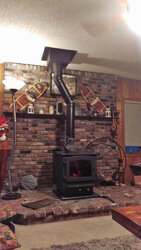Hi there, first time poster. I recently swapped out our old Fisher for an Englander. not sure what model it is but it said it will heat 1,800-2,400sq feet. I have poor draft now, but was fine with the Fisher. Everything I've read leads me to believe I need more chimney, so I added another 20" of class A. Even with over 16' of chimney I can't get a good draft going, plus the glass is pitch black. I have two more 30" sections of class A but the thing is getting really tall. should I keep adding to it or do I have another problem?
Here's my setup:
6" connecting pipe to support box with two slight angle changes
7" class A for 110"
Wide open cap
Good pine, which ive burned in three other stoves to check quality.

Here's my setup:
6" connecting pipe to support box with two slight angle changes
7" class A for 110"
Wide open cap
Good pine, which ive burned in three other stoves to check quality.

Last edited by a moderator:

